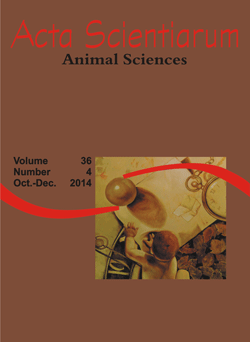<b>Defoliation patterns and tillering dynamics in Italian ryegrass under different herbage allowances
Abstract
This work was carried out in order to generate information on the tillering process and to contribute for the understanding of the defoliation process on Italian ryegrass (Lolium multiflorum Lam.) grazed by lambs under different herbage allowances: 6, 8 and12 kg of dry matter per100 kg of animal live weight per day. The grazing method was intermittent. The experimental design was completely randomized following a repeated measure arrangement, with three treatments and two area replications. The intensity of defoliation is greater at 6 and 9% herbage allowances. The defoliation interval is higher at 12% herbage allowance, intermediate at 9% and lower at 6%. The rates of tiller emergence, survival and death, stability index the tiller population are similar for the different herbage allowances and differ according to the phenological stage of ryegrass. Structural changes caused by canopy management with low herbage allowance and/or due to the advance in developmental stage of ryegrass alter defoliation strategies, with more intense and frequent grazing.
Downloads
References
ALEXANDRINO, E.; NASCIMENTO JUNIOR, D.; MOSQUIM, P.R.; REGAZZI, A.J.; ROCHA, F.C. Características morfogênicas e estruturais na rebrotação da Brachiaria brizantha cv. Marandu. submetida a três doses de nitrogênio. Revista Brasileira de Zootecnia, v. 33, n.6, p. 1372-1379, 2004.
BAHMANI, I.; THOM, E.R.; MATTHEW, C.; HOOPER, R.J.; LEMAIRE, G. Tiller dynamics of perennial ryegrass cultivars derived from different New Zealand ecotype: effects of cultivar, season, nitrogen fertilizer and irrigation. Australian Journal of Agricultural Research, v.54, p.803-817, 2003.
BARTH NETO, A.; CARVALHO, P.C.F.; LEMAIRE, G.; SBRISSIA, A.F.; CANTO, M.W. do; SAVIAN, J.V.; AMARAL, G.A. do; BREMM, C. Perfilhamento em pastagem de azevém em sucessão a soja ou milho, sob diferentes métodos e intensidades de pastejo. Pesquisa Agropecuária Brasileira, v.48, n.3, p. 329-338, 2013.
CAMINHA, F.O.; SILVA, S.C. da; PAIVA, A.J.; PEREIRA, L.E.T.; MESQUITA, P. de; GUARDA, V.D.A. Estabilidade da população de perfilhos de capim marandu sob lotação contínua e adubação nitrogenada. Pesquisa Agropecuária Brasileira, v.45, n.2, p.213-220, 2010.
CARVALHO, P.C.F. O manejo da pastagem como gerador de ambientes pastoris adequados à produção animal. In: Simpósio sobre Manejo da Pastagem, 22., Piracicaba, 2005. Anais. Piracicaba: FEALQ, 2005. p. 07-32.
CAUDURO, G. F.; CARVALHO, P.C.F; BARBOSA, C.M.P.; LUNARDI, R.; NABINGER, C.; GONÇALVES, E.N.; DEVINCENZI, T. Variáveis morfogênicas e estruturais de azevém anual (Lolium multiflorum Lam.) manejado sob diferentes intensidades e métodos de pastejo. Revista Brasileira de Zootecnia, v.35, n.4, p.1298-1307, 2006.
CONFORTIN, A.C.C.; ROCHA, M.G. da; QUADROS, F.L.F de; GLIENKE, C.L.; ROSSI, G.E.; MORAES, A.B. de Características estruturais e morfogênicas de aveia preta e azevém anual sob duas intensidades de pastejo. Revista Brasileira de Zootecnia, v.39, p.2357- 2365, 2010a.
CONFORTIN, A.C.C.; QUADROS, F.L.F de; ROCHA, M.G. da; CAMARGO, D.G. de; GLIENKE, C.L.; KUINCHTNER, B. Morfogênese e estrutura de azevém anual submetido a três intensidades de pastejo. Acta Scientiarum. Animal Science, v.32, n.4, p. 385-391, 2010b.
CONFORTIN, A.C.C.; ROCHA, M.G. da; MACHADO, J.M.; ROMAN J.; QUADROS, F.L.F de; PÖTTER, L. Diferentes massas de forragem sobre as variáveis morfogênicas e estruturais do azevém anual. Ciência Rural, v.43, n.3, p.496-502, 2013.
ELYAS, A.C.W.; PINTO, J.C.; FURTINI NETO, A.E; MORAIS, A.R. de Nitrogênio e saturação de bases no desempenho do capim-pojuca (Paspalum swalen cv. Pojuca) cultivado em vasos. Ciência e Agrotecnologia, v.30, n.3, p.554-561, 2006.
HODGSON, J. Grazing management. Science into practice. England, Longman Scientific & Technical, 1990. 203p
LEMAIRE, G.; CHAPMAN, C. Tissue flows in grazed plant communities. In: HODGSON, J.; ILLIUS, A.W. (Eds.) The ecology and management of grazing systems.Wallingford : CAB International, 1996. p.3-36.
LEMAIRE, G.; AGNUSDEI, M. Leaf tissue turnover and efficiency of herbage utilization. In: LEMAIRE, G.; HODGSON, J.; MORAES, A.; NABINGER, C; CARVALHO, P.C.F. (Eds). Grassland ecophysiology and grazing ecology.Wallingford : CABI International, 2000. p. 265-288.
MACHADO, J.M.; ROCHA, M.G. da; MORAES, A.B. de; CONFORTIN, A.C.C.; OLIVEIRA NETO, R.A. de Intensidade e frequência de desfolha em azevém. Revista Brasileira Agrociência, v.17, n. 3-4, p. 365-374, 2011.
MATTHEW, C.; ASSUERO, S.G.; BLACK, C.K.; SACKVILLE HAMILTON, N.R. Tiller dynamics of grazed swards. In: LEMAIRE, G.; HODGSON, J.; MORAES, A.; NABINGER, C; CARVALHO, P.C.F. (Eds). Grassland ecophysiology and grazing ecology. Wallingford: CABI, 2000. p.127 150.
PALHANO, A. L.; CARVALHO, P.C.F; DITTRICH,J.R.; MORAES, A. de; BARRETO, M.Z.; SANTOS, C.F. dos Estrutura e padrões de desfolhação em Capim-Mombaça em diferentes alturas do dossel forrageiro. Revista Brasileira de Zootecnia, v.34, n.6, p.1860-1870, 2005.
PEDROSO, C.E.S.; MEDEIROS, R.B.de; SILVA, M.A. da; JORNADA, J.B.J. de; SAIBRO, J.C. de; TEIXEIRA, J.R.F. Produção de ovinos em gestação e lactação sob pastejo em diferentes estádios fenológicos de azevém anual. Revista Brasileira de Zootecnia, Viçosa, v.33, n.5, p.1345-1350, 2004.
PONTES, L. S.; CARVALHO, P.C.F ; NABINGER, C.; SOARES, A.B. Fluxo de biomassa em pastagem de Azevém anual (Lolium multiflorum Lam.) manejada em diferentes alturas. Revista Brasileira de Zootecnia, v.33, n.3, p.529-537, 2004.
SBRISSIA, A.F.; DA SILVA, S.C. Compensação tamanho/densidade populacional de perfilhos em pastos de capim-marandu. Revista Brasileira de Zootecnia, v.37, n.1, p.35-47, 2008.
DECLARATION OF ORIGINALITY AND COPYRIGHTS
- I Declare that current article is original and has not been submitted for publication, in part or in whole, to any other national or international journal.
The copyrights belong exclusively to the authors. Published content is licensed under Creative Commons Attribution 4.0 (CC BY 4.0) guidelines, which allows sharing (copy and distribution of the material in any medium or format) and adaptation (remix, transform, and build upon the material) for any purpose, even commercially, under the terms of attribution.
Read this link for further information on how to use CC BY 4.0 properly.








































